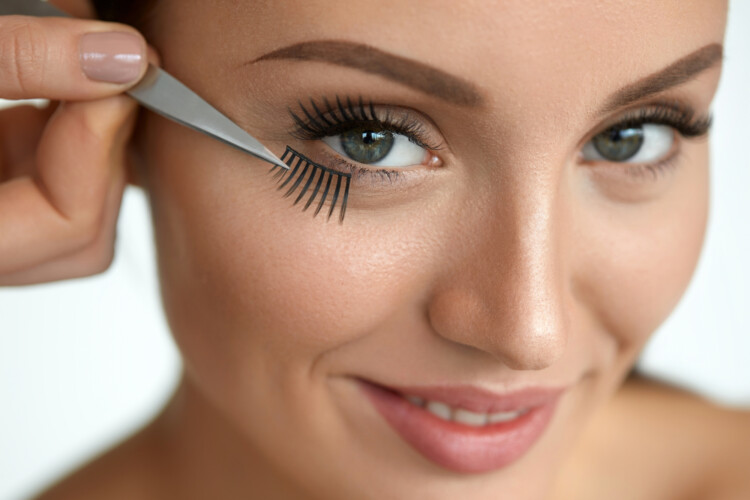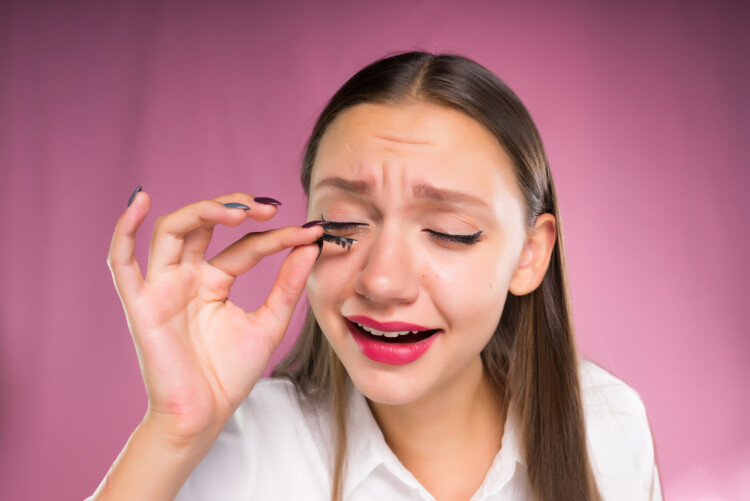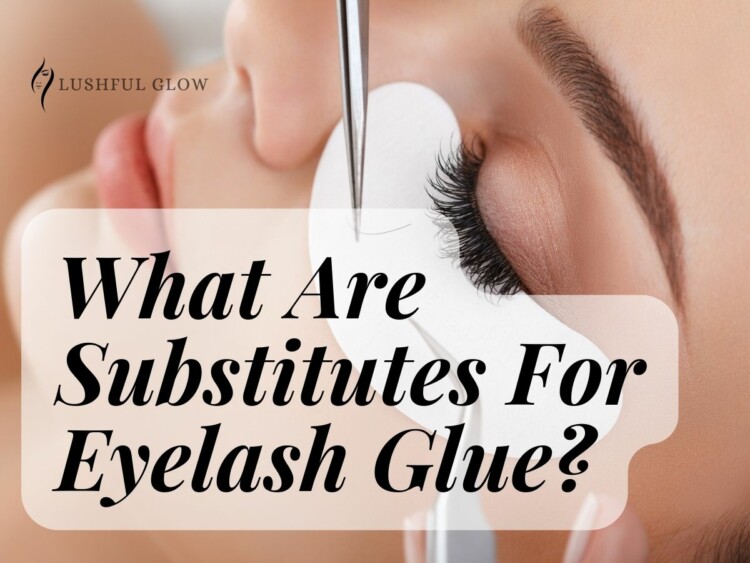Searching for that tiny black tube of glue in the sea of your makeup bag can be more difficult than finding a needle in a haystack.
And even when you finally locate it, the lid is always missing. But the real nightmare begins when you realize that there’s no glue left inside.
Running out of eyelash glue is truly one of the worst things that can happen to anybody.
Not only does it make it impossible to apply false lashes, but it also leaves you with a feeling of utter helplessness.
Luckily, there are eyelash alternatives that are available in the market.
Before we discuss them, it’s important that we find out whether they are effective at all or not.
Contents
Are Glue Alternatives Effective?

If you’re looking for a way to ditch the glue but still keep your falsies in place, there are a few options available.
Adhesive strips, for instance, are highly effective and can provide a stronghold.
However, it’s important to note that not every alternative is as effective as adhesive strips.
False lashes with built-in glue, for example, may not provide the same level of hold.
If you’re looking for a stronghold, adhesive strips are the way to go.
If you’re looking for something a little less permanent, false lashes with built-in glue may be a better option.
Substitutes For Eyelash Glue
Following are some substitutes for eyelash glue:
1. Adhesive Strips
Adhesive strips are a popular alternative to lash glue, and for good reason. They are much easier to apply, and they cause less irritation to the eyes.
They also last longer, making them a good choice for special occasions.
However, there are a few things to keep in mind when using adhesive strips.
First of all, it’s important to make sure that the strips are placed on clean, dry lashes.
Otherwise, they will not adhere properly.
Second, be careful not to get any of the adhesives on your skin, as it can be difficult to remove.
Finally, avoid using adhesive strips if you have sensitive skin or eyes, as they may cause irritation.
Overall, adhesive strips are a convenient and safe way to apply false lashes.
2. Self-Adhesive Lashes
If you’re looking for an easier alternative, self-adhesive lashes with built-in glue are a good option.
These lashes come with a strip of adhesive already applied, so all you need to do is press them into place.
The built-in glue will hold the lashes in place all day, and it’s also much less likely to cause irritation than traditional lash glue.
If you’re new to falsies, self-adhesive lashes with built-in glue are a great way to get started.
3. Lash Serums
When it comes to falsies, there are a few different options for adhesive.
Lash glue is a popular choice, but it can be tricky to work with, and it’s not always the safest option for sensitive skin.
Lash serums are a great alternative to lash glue, and they have a few key benefits.
First, lash serums are much easier to apply than lash glue.
Second, they’re gentle on the skin, so they’re a good option for people with sensitive eyes or skin.
Also, lash serums help to strengthen and condition the lashes, so they’re less likely to break or fall out.
As a result, lash serums can be considered a great choice for people who want healthy, beautiful lashes.
4. Lash Growth Mask
A lash growth mask is a type of facial mask that is used to encourage the growth of eyelashes.
The mask is applied to the lashes and left on for a period of time, typically 10-15 minutes.
Lash growth masks typically contain ingredients that are known to promote hair growth, such as biotin and keratin.
In addition, lash growth masks often contain nourishing ingredients that can help to strengthen and condition the lashes.
While there is no scientific evidence to show that lash growth masks are effective, many people report seeing longer, thicker lashes after using these products.
If you’re looking for an alternative to lash glue, this might help you
5. Magnetic Eyelashes
If you’re looking for a way to achieve full, stunning lashes while ditching the lash glue at the same time, you may want to try magnetic eyelashes.
These falsies are held in place by tiny magnets, so there’s no need for lash glue or any other adhesive.
And because they attach directly to your natural lashes, they blend in seamlessly for a natural look.
Best of all, they’re easy to apply and remove, so you can get perfect lashes in a matter of seconds.
If you’re tired of struggling with traditional false eyelashes, give magnetic lashes a try.
Check the video below for some tips when applying magnetic lashes.
Side Effects Of Eyelash Glue
Here are some of the side effects of eyelash glue:
1. Irritation
Many people use eyelash glue to help them achieve the perfect look, but what they may not realize is that this glue can actually cause irritation in their eyes.
The ingredients in the glue, which include propylene glycol and formaldehyde, can cause redness, swelling, and burning.
In addition, if the glue is not applied properly, it can actually pull out your natural lashes.
For these reasons, it’s important to be very careful when using eyelash glue.
If you experience any irritation, make sure to remove the glue immediately and consult a doctor if necessary.
2. Rash
Many women rely on eyelash adhesive to keep their false eyelashes in place.
However, this type of adhesive can sometimes cause a rash on the skin around the eyes.
The rash may be itchy and uncomfortable, and it can also lead to redness and swelling.
In severe cases, the rash may blister or bleed.
If you experience a rash after using eyelash adhesive, discontinue use and consult a doctor.
You may need to use a mild steroid cream to reduce inflammation, or you may need to take oral antiviral medication if the rash is caused by a virus.
With proper treatment, most rashes will clear up within a few days.
3. Swelling
Lashes adhesives at times fall off mid-way through the day.
However, even more, frustrating is when lash adhesive works too well, causing swelling and irritation.
In some cases, this can even lead to temporary blindness.
As a result, it’s important to be very careful when choosing and using eyelash adhesive.
If possible, opt for a hypoallergenic variety to minimize the risk of irritation.
And always make sure to test the adhesive on a small area of skin before applying it to your lashes.
The Benefits of Using Substitutes For Eyelash Glue
For many people, false eyelashes are an essential part of their beauty routine.
Unfortunately, the glue that is used to apply false lashes can often cause allergic reactions and irritation.
Fortunately, there are some safe and gentle substitutes that can be utilized in place of traditional eyelash glue.
A popular alternative is nail polish.
Just apply a minute amount of polish to the lash band and let it dry completely.
Once it is dry, the lash will adhere just as well as it would with traditional glue. Another alternative is vaseline.
Simply apply a small amount of Vaseline to the lash band. This will help to hold the lashes in place without causing any irritation.
If you wear false lashes on a regular basis, it is worth taking the time to find a safe and gentle alternative to traditional eyelash glue.
By doing so, you can avoid any potential irritation or allergic reactions.
Why Should I Prefer Substitutes For Eyelash Glue?

When it comes to beauty products, there are few things more personal than the products we use to style our hair.
We all have our own unique preferences, and what works for one person may not work for another.
This is certainly true when it comes to eyelash glue.
While there are many different brands and formulas on the market, they all essentially serve the same purpose: to adhere eyelashes to lash lines.
However, there are a number of drawbacks that should be considered before using any type of eyelash glue.
The first is that most eyelash glues contain harsh chemicals that can irritate the delicate skin around the eyes.
In addition, if not applied correctly, eyelash glue can cause the lashes to adhere to the skin, which can be painful and difficult to remove.
Plus, lash glues can also cause allergic reactions in some people.
If you experience any redness, swelling, or itchiness after applying the eyelash glue, discontinue use immediately and consult a doctor.
It should also be noted that while substitutes for eyelash glue may be convenient, they also come with a number of risks that should be taken into consideration.
Frequently Asked Questions
Does castor oil remove eyelash glue?
Any oil, including castor oil, helps remove eyelash glue.
So if you don’t want to remove your falsies or lash extensions yet, stay away from oil and oil-based cleansers.
If you want to remove them, however, it is best to apply castor oil on your lashes before you sleep so it can slowly work on loosening the adhesive.
Is it bad to use old lash glue?
Yes, it is never good to use old lash glue.
If it has been sitting there for a long time, it is better to use something new to avoid the risk of irritation and infection.
Final Thoughts
So there you have it – a few substitutes for eyelash glue that will help keep your falsies in place.
Whether you’re looking for an all-natural solution or something that can hold up through the toughest workouts, this article has got you covered.

